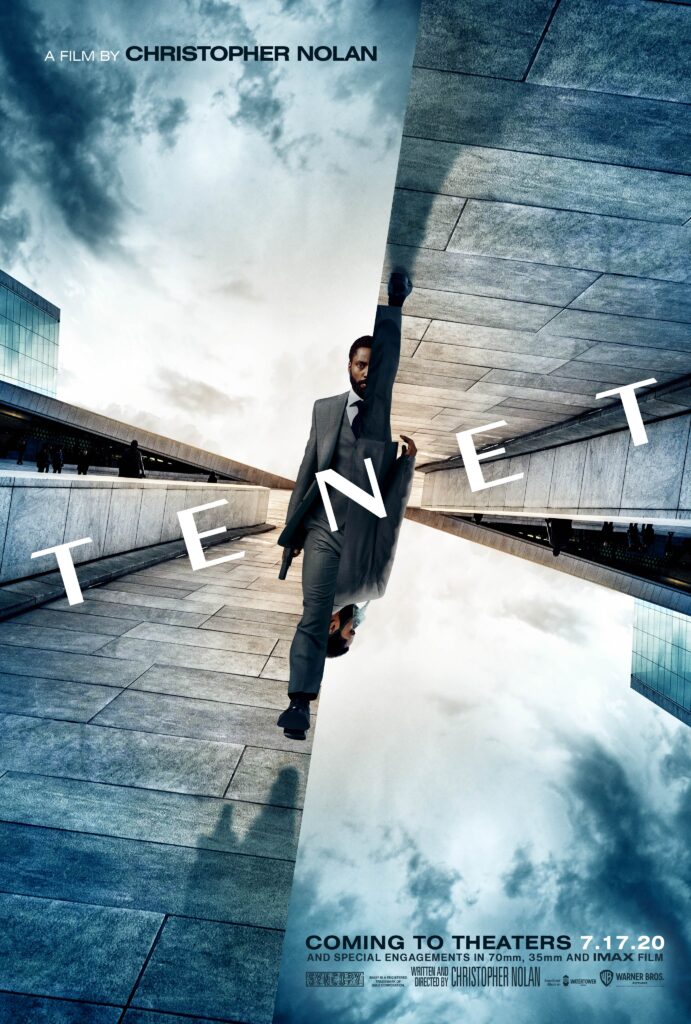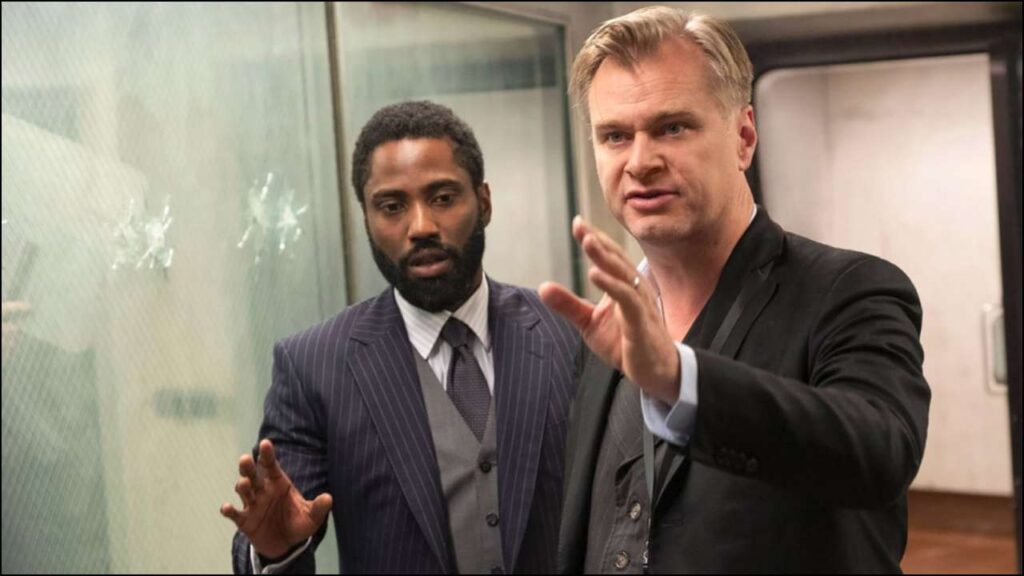
By Thomas Manning

Whenever Christopher Nolan takes on a project as a director, it is understood that the final product will be a true spectacle, destined for the largest theatrical screen possible. From his smaller indie roots with “Following” (1998), “Memento” (2000), and “Insomnia” (2002), to his game-changing “Dark Knight” trilogy (2005-2012), to his mind-bending sci-fi dramas like “Inception” (2010) and “Interstellar” (2014), to his historical war epic with “Dunkirk” (2017), Nolan is certainly one of the most influential filmmakers of the last quarter-century. Perhaps more than anything, Nolan’s fixation with the manipulation of time and non-linear storytelling is his most notable trademark. With his latest feature as both director and screenwriter, “Tenet“, Nolan somehow manages to outdo every complicated bit of temporal modification that has ever been introduced into his filmography, for better or for worse.

At a basic level, the plot of the film is a fairly straightforward international espionage story, with John David Washington’s character (a CIA agent known only as “The Protagonist”) stumbling onto a massive conspiracy, involving the mysterious, extremely wealthy, and powerful Russian oligarch, Andrei Sator (Kenneth Branagh). Also within the fold is Sator’s wife, Kat (Elizabeth Debicki), a woman trapped in a loveless, emotionally abusive marriage, desperately clinging to the hope of a better life for her young son, Max (Laurie Shepherd). The Protagonist’s primary ally is the suave character of Neil (Robert Pattinson), a competent spy, skilled combatant, and capable business handler of unknown origins. The Protagonist is wary of Neil but recognizes that this partnership is his best bet in unraveling the dangerous web of deceit. Naturally, this intricate network of interwoven character arcs is also where Nolan’s signature time antics come into play. Enter the concept of “inversion.”
From the viewer’s perspective, some of the characters and objects move forward through time and space normally, as others are inverted, and traveling backward. Not only are they going to an earlier time and place from a chronological point of view, but they are traversing that time and space in reverse motion. The laws of physics are inverted as well. Essentially, if an individual wanted to travel back in time 24 hours, they would physically have to live those 24 hours in an inverted state, in order to reach their desired temporal destination. Yes, it is all remarkably perplexing. But, it also provides a unique route for extraordinarily daring, original, and creative action set pieces. Considering that enemies and allies with competing interests and conflicting goals are trekking both forward and backward through time simultaneously, the possibilities for Nolan’s genius to shine through are endless. The efforts from the digital VFX artists and special effects units blend into a beautiful symphony of technical filmmaking glory. A great deal of the effects are carried out practically, in-camera, including the crashing of a 747 aircraft from a runway into a hangar. CGI is used sparingly, but the output from this crew remains impressive and significant to the success of the action sequences. The greatest uses of special effects in film are those that manage to integrate practicality and digital enhancement almost seamlessly, to the point where the viewer cannot tell where the practical special effects end and the computer-generated enhancements begin. The effects in “Tenet” are a prime example of this achievement.

The extent of the astonishing visuals in “Tenet” reaches much further than inverted explosions, reverse car chases and chaotic gunplay. One must also acknowledge the stunt team and choreography supervisors. There is one scene in particular (which can be found in the trailer, no spoiler here) that features The Protagonist, moving linearly through time, squaring off in a fierce melee against an inverted assailant, who is heading in the opposite temporal direction. Some of the pre-released behind-the-scenes reels reveal that this physical coordination is authentic. The stunt performers literally had to learn how to fight in reverse. The dedication to pure filmmaking craft on display here is something to behold.
Concerning the star-studded cast, the charismatic performances live up to expectations. “Tenet” is John David Washington’s second lead role in a film, on the heels of his Golden Globe-nominated performance in the Spike Lee Joint, “Blackkklansman” (2018). He exudes raw confidence in every scene, and not only holds his own, but shines brightly on-screen with seasoned veterans like Pattison and Branagh, not to mention a critical cameo from legendary talent Michael Caine. The chemistry, sometimes volatile, among each member of the cast of characters is developed efficiently. However, the criticism can be made that as the viewer, we are so focused on dissecting the quantum physics and converging timeline gimmicks that the emotional core of the narrative is diminished. The elements are present, and repeat viewings will unveil more layers of pathos, with Debicki’s character especially. Still, perhaps another draft of the script, or even a co-writer with a steadier hand, would have refined the final product.
If you have read any other review from “Tenet“, you have likely heard of the distracting sound editing and mixing. Unfortunately, I concur that Nolan’s Achilles heel continues to be a weakness. The overwhelming, earth-shaking blares of a Hans Zimmer score are replicated by Ludwig Göransson here, in Nolan’s first collaboration with the Oscar-winning composer. The compositions themselves are excellent pieces of music that serve as energy-filled atmospheric ambiance. On the other hand, this music is obnoxiously loud. I previously noted that I have seen “Tenet” twice at this point, at two separate theaters. My initial theatrical experience was an unmitigated disaster, in large part due to the sound system’s incapability to process the deafening audio. (The picture was also formatted incorrectly at this showing, and the projector shut down at the climax of the movie). Alas, my second viewing was at a more upscale establishment, with better speaker technology, a proper aspect ratio, and no projector interruptions, which made the overall ordeal much more enjoyable. Despite all of this, the sound mix is still something I must pinpoint as a detractor. There were key bits of dialogue that I misheard or did not understand at all. While these issues tend to go with the territory in Nolan films, like “The Dark Knight“, “Inception” and “Interstellar“, Tenet is by far the most glaring example of this lapse in filmmaking judgment from the director.
Taking this all into account, “Tenet” is still a must-watch action thriller for cinephiles everywhere. For the moment, I am going to consider it to be mid-tier Nolan, but his standards are a different breed. Mid-tier Nolan is far superior to the best films from many directors. I can easily see my love and appreciation for this one growing with each ensuing rewatch, for there are bound to be many. Yet, I cannot in good conscious recommend that readers rush out to theaters to watch this one in the midst of the deadly Covid-19 pandemic, unless you feel completely safe and comfortable. Thankfully, the theaters I attended took abundant safety precautions and sanitation measures, with mask rules enforced and limited capacity. It is ultimately up to each individual to make this decision, but proceeding with caution is of the utmost importance.
Score: 4/5
(All images courtesy of Warner Brothers Studios)
